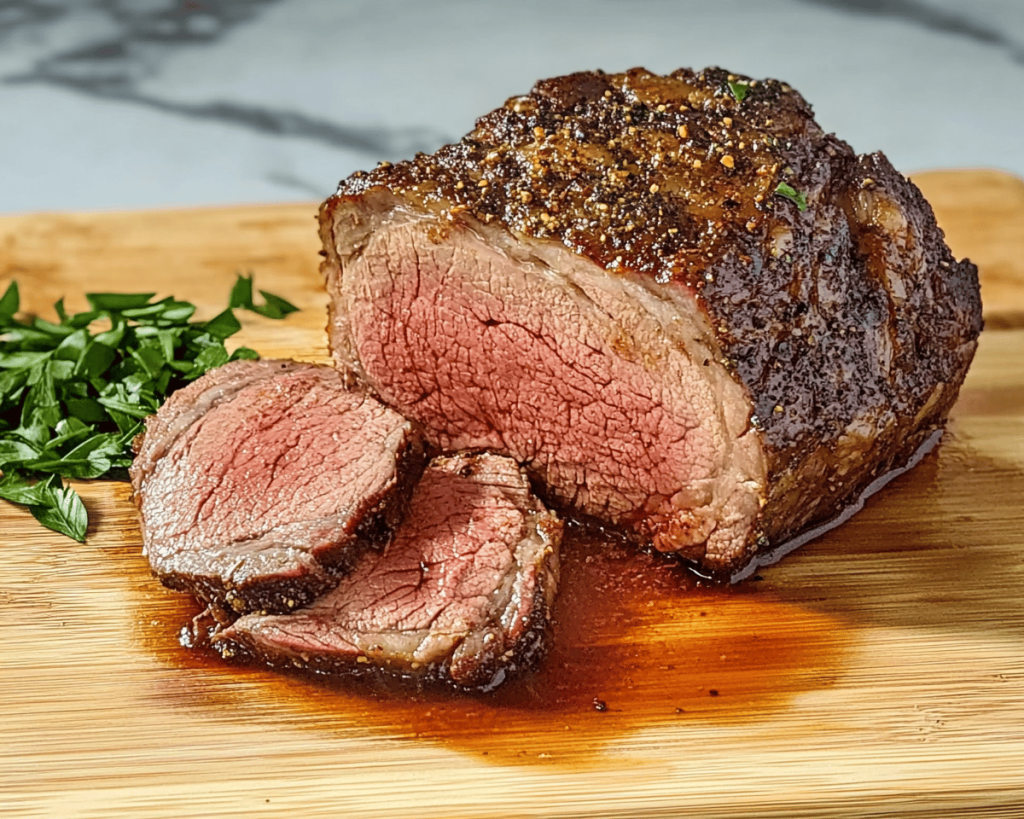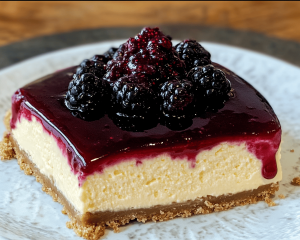There’s something almost transcendent about a perfectly roasted beef—its aroma wafting through the air as it cooks, the way the juices begin to meld together into a rich, savory gravy, and oh, that glorious crust that forms on the outside. For me, making a classic roast beef isn’t just about following a recipe; it’s about connection. It’s a ritual that ties me to my childhood, weekend family dinners, and those long, lazy Sunday afternoons spent at the table. It’s the heart of comfort food, the anchor that holds cherished memories tightly woven into its fibers.
I first learned to make roast beef from my grandmother, who always seemed to wield her apron and a roast like a maestro, conducting an orchestra of enticing flavors. I remember how she would mutter to herself, “A pinch of this, a dash of that,” as if her roasting techniques were passed down through some ancient culinary whisper. Sometimes it came out perfect, and sometimes… well, let’s just say it was an adventure. But never once did we let it go to waste; each roast had its own character, a story to tell. Now, every time I roast a piece of beef, I hear her voice, urging me to trust my instincts and embrace the imperfections.
That’s what this recipe embodies for me—it’s a little messy, a tad unpredictable, but ultimately, it’s unforgettable.
What Goes Into Classic Roast Beef?
Let’s dive into the ingredients that come together to create this unforgettable dish. Each one has its place and purpose, and you might even have a special memory linked to them. Here’s the lowdown:
Beef Roast: This is the star of the show. I usually go for a boneless ribeye or a sirloin roast because they’re juicy and flavorful. Honestly, you can’t go wrong with something that has a bit of marbling—it helps keep it moist. One tip: ask your butcher for advice! They love to help and sometimes have recommendations for cuts that work well based on the time of year or what’s freshest.
Salt: You simply can’t underestimate the power of salt. When I was a kid, I always worried I’d over-salt something, but trust me—it’s one of those things you want to err on the side of generous for. It draws out the beef’s natural flavors, bringing it to life. Rule of thumb? A good, liberally-applied coat on the outside.
Pepper: Freshly cracked black pepper is my go-to. It adds a pungent kick that complements the richness of the beef. At one point, I tried using pre-ground pepper, but I swear it just doesn’t have the same oomph. Now, I always keep my pepper grinder handy.
Garlic: I love the warmth and richness that roasted garlic brings to this dish. It’s a must-have! I usually toss in whole cloves in the pan, allowing them to slowly caramelize as the beef roasts.
Fresh Herbs: This is where you can get a little creative! I typically lean toward rosemary and thyme because they pair beautifully with beef. What’s fantastic is that they not only add flavor, but the aroma that fills your kitchen is nothing short of heavenly. Sometimes I get all fancy and tie them together like my grandmother showed me, but honestly, I eyeball it most of the time. I guess I inherited her do-it-by-feel style.
Olive Oil: A drizzle gives the beef a nice sheen and helps the spices stick. I have a penchant for a certain brand that my Italian aunt always uses—there’s just something about the flavor that reminds me of her feasts. If you have a favorite, don’t hesitate to splurge a little!
Vegetables: While it’s technically optional, I highly recommend adding some root vegetables like carrots, potatoes, and onions to the roasting pan. They soak up all those amazing juices and make for a colorful, hearty side. Think of them as support characters in this blockbuster!
Is Classic Roast Beef Actually Good for You?
Now, let’s get real for a minute—classic roast beef is undeniably indulgent, and it’s often the main feature at family celebrations and holiday dinners. But, here’s the thing: it can be an empowering centerpiece for a balanced meal if enjoyed thoughtfully.
Leaning into the health aspect, let’s talk about the beef itself. While it’s true that red meat can be high in saturated fat, there’s growing wisdom about the nutritional benefits when enjoyed in moderation. You’re getting a solid dose of protein (hello muscle repair!) and essential nutrients like iron, zinc, and B-vitamins. Choosing a good quality cut can make a difference, too.
And then there are those veggies! Adding carrots, potatoes, and onions can add vitamins and minerals while also elevating the flavor profile of your roast. Honestly, I’m all about that balance—the rich flavor of beef paired with these hearty, satisfying, and nutritious components makes me feel less guilty about treating myself.
Here’s What You’ll Need
– 3 to 4-pound boneless ribeye or sirloin roast (or your favorite cut)
– Salt (about 2 teaspoons)
– Freshly cracked black pepper (to taste)
– 4 to 6 cloves of garlic (whole)
– 2 tablespoons extra virgin olive oil
– A handful of fresh rosemary and thyme (or your herb of choice)
– 2 medium onions (quartered)
– 4 carrots (cut into 1-inch pieces)
– 4 medium potatoes (cut into quarters)
How to Make Classic Roast Beef Step-by-Step
Alright, friends, it’s time to dive into the messy, beautiful process of roasting beef. Don’t be intimidated—this is where the magic happens, and I promise it’s more forgiving than you think!
1. **Preheat Your Oven**: Set your oven to 450°F (230°C). It sounds high, but we want to get that initial sizzle going!
2. **Prep the Beef**: Take the roast out of the fridge about 30 minutes prior to cooking. We want it to come to room temperature—it helps with even cooking. Pat it dry with a paper towel to help get a nice crust.
3. **Season It Well**: Grab that salt and pepper. This is where you apply a generous amount—don’t hold back! After seasoning, drizzle with olive oil and rub it all over. Don’t be shy; you want that flavor to penetrate every nook and cranny.
4. **Add Garlic and Herbs**: Insert those whole garlic cloves into the roast’s crevices, and lay down fresh herbs on top of the beef. It’s becoming a masterpiece, I can feel it!
5. **Vegetable Bed**: In a roasting pan, pile in those chopped onions, carrots, and potatoes. Drizzle a little olive oil over them and sprinkle with salt and pepper. They’ll be your cheering squad during this roast.
6. **Roast Away**: Place the beef on top of the vegetables and slide the pan into the oven. Roasting at 450°F for about 15-20 minutes gives you a fantastic crust. Then lower the temperature to 325°F (160°C) and keep roast for about 1.5 to 2 hours, depending on how you like your beef done. Use a meat thermometer—it’s the best tool ever! Aim for 135°F (57°C) for medium-rare.
7. **Resting is Key**: This is where the magic happens, folks. Once it’s cooked, pull it from the oven and let it rest for at least 20 minutes. This gives the juices time to redistribute within the meat—trust me, you want this!
8. **Carve and Serve**: Slice up that beauty against the grain to maximize tenderness. Serve it up alongside those wonderfully roasted veggies, and don’t forget to pour some of the drippings over the meat for an added explosion of flavor.
Little Extras I’ve Learned Along the Way
Now, let’s be honest. No roast is ever truly the same. Life happens, and sometimes you need to improvise. Here are some handy tips I’ve picked up along the journey:
– **Basting**: If you’re feeling fancy, baste the beef with the drippings every half hour. This is where you really amp up the moisture and flavor. Just be careful—you don’t want to open the oven too often and let heat escape.
– **Different Cuts**: You don’t have to stick to my first-choice cuts. Try experimenting with a bottom round or a chuck roast. It might require a different cooking time, but you’ll find some hidden gems out there!
– **Alternate Seasonings**: Feel free to mix up the herbs! Sometimes parsley, sage, or oregano can add a unique twist. And if you’re feeling wild, a pinch of smoked paprika can give it a smoky depth.
– **Leftover Treats**: Don’t throw that carcass away! Use the bones and leftover roast to create a fantastic beef stock. Just simmer it with vegetables and herbs, and you’ll have a rich, hearty base for soups.
– **A Little Wine**: I’ll occasionally throw some red wine into the pan when it’s roasting. It adds a nice depth to the gravy and helps deglaze the pan afterward for a delicious sauce. Talk about a win-win!
This one means a lot to me. Roasting a beef is about gathering together with the people you love, sharing stories, and, yes, sometimes even laughing over the roast that didn’t turn out quite how you wanted it. It’s a chance to create new memories, just like those afternoons with my grandmother.
I hope you’ll give this classic roast beef recipe a try. I’d love to hear your version or any stories you have associated with it. Cooking is all about the connections we cultivate, and I can’t wait for you to make some of your own!



